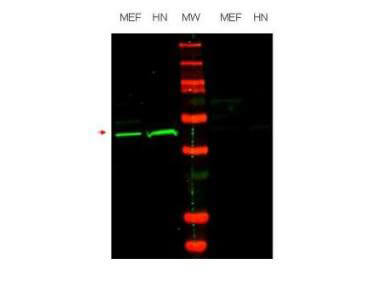Anti-Oct-4 (RABBIT) Antibody
Oct-4 Antibody
- SPECIFICATION
- CITATIONS
- PROTOCOLS
- BACKGROUND

| Host | Rabbit |
|---|---|
| Conjugate | Unconjugated |
| Target Species | Human |
| Reactivity | Human, Mouse |
| Clonality | Polyclonal |
Application
| WB, E, IP, I, LCI |
| Application Note | This affinity purified antibody has been tested for use in ELISA and western blotting. |
| Physical State | Liquid (sterile filtered) |
| Buffer | 0.02 M Potassium Phosphate, 0.15 M Sodium Chloride, pH 7.2 |
| Immunogen | This affinity purified antibody was prepared from whole rabbit serum produced by repeated immunizations with a synthetic peptide corresponding to an internal region of human Oct-4 protein. |
| Preservative | 0.01% (w/v) Sodium Azide |
| Gene ID | 5460 |
|---|---|
| Other Names | 5460 |
| Purity | This product was affinity purified from monospecific antiserum by immunoaffinity chromatography. This antibody reacts with human and mouse Oct-4 protein. Cross-reactivity with Oct-4 from other species has not been tested. A BLAST analysis was used to suggest additional cross-reactivity with Oct-4 from chimpanzee, macaque and horse based on a 100% homology with the immunizing sequence; and mink, dog, bovine and pig based on a 93% homology. |
| Storage Condition | Store vial at -20° C prior to opening. Aliquot contents and freeze at -20° C or below for extended storage. Avoid cycles of freezing and thawing. Centrifuge product if not completely clear after standing at room temperature. This product is stable for several weeks at 4° C as an undiluted liquid. Dilute only prior to immediate use. |
| Precautions Note | This product is for research use only and is not intended for therapeutic or diagnostic applications. |
| Name | POU5F1 |
|---|---|
| Synonyms | OCT3, OCT4, OTF3 |
| Function | Transcription factor that binds to the octamer motif (5'- ATTTGCAT-3'). Forms a trimeric complex with SOX2 or SOX15 on DNA and controls the expression of a number of genes involved in embryonic development such as YES1, FGF4, UTF1 and ZFP206. Critical for early embryogenesis and for embryonic stem cell pluripotency. |
| Cellular Location | Cytoplasm. Nucleus. Note=Expressed in a diffuse and slightly punctuate pattern. Colocalizes with MAPK8 and MAPK9 in the nucleus. {ECO:0000250|UniProtKB:P20263, ECO:0000269|PubMed:18191611, ECO:0000269|PubMed:19274063, ECO:0000269|PubMed:23024368} |
| Tissue Location | Expressed in developing brain. Highest levels found in specific cell layers of the cortex, the olfactory bulb, the hippocampus and the cerebellum. Low levels of expression in adult tissues. |

Thousands of laboratories across the world have published research that depended on the performance of antibodies from Abcepta to advance their research. Check out links to articles that cite our products in major peer-reviewed journals, organized by research category.
info@abcepta.com, and receive a free "I Love Antibodies" mug.
Provided below are standard protocols that you may find useful for product applications.
Background
Oct-4, also known as POU domain transcription factor, Octomer- binding transcription factor 3 and Oct-3, is expressed in human and mouse totipotent embryonic stem and germ cells. It may function in preventing these cells from differentiating. Each type of established mammalian pluripotent stem cell line (embryonal carcinoma (EC) cells, embryonic stem (ES) cells and embryonic germ (EG) cells) expresses Oct-4, which disappears rapidly when the cells differentiate. Most studies on Oct-4 have been performed on murine embryos. In human oocytes of various maturity and normally developing preimplantation/cleavage embryos, a variable Oct-4 expression pattern has been revealed, concomitant with a pure cytoplasmic localization of the protein. This variability in expression fades away during compaction, indicating embryonic Oct-4 expression; the protein appears in the nucleus, implying biological activity. Functional Oct-4 has been found in human amniotic fluid. As Oct-4 transcripts have also been found in various differentiated cells, the presence of Oct-4 transcripts or proteins may not be sufficient for identifying undifferentiated cell lines in humans. It may also be important to examine the localization of Oct-4 proteins within a cell. Oct-4 has been shown to interact with Nanog and with proteins from multiple repression complexes, including the NuRD, Sin3A and Pml complexes, possibly to control ES fate. Reactivation of Oct-4 expression is postulated to occur in differentiated cells that have undergone carcinogenesis, or tumor formation.
If you have used an Abcepta product and would like to share how it has performed, please click on the "Submit Review" button and provide the requested information. Our staff will examine and post your review and contact you if needed.
If you have any additional inquiries please email technical services at tech@abcepta.com.













 Foundational characteristics of cancer include proliferation, angiogenesis, migration, evasion of apoptosis, and cellular immortality. Find key markers for these cellular processes and antibodies to detect them.
Foundational characteristics of cancer include proliferation, angiogenesis, migration, evasion of apoptosis, and cellular immortality. Find key markers for these cellular processes and antibodies to detect them. The SUMOplot™ Analysis Program predicts and scores sumoylation sites in your protein. SUMOylation is a post-translational modification involved in various cellular processes, such as nuclear-cytosolic transport, transcriptional regulation, apoptosis, protein stability, response to stress, and progression through the cell cycle.
The SUMOplot™ Analysis Program predicts and scores sumoylation sites in your protein. SUMOylation is a post-translational modification involved in various cellular processes, such as nuclear-cytosolic transport, transcriptional regulation, apoptosis, protein stability, response to stress, and progression through the cell cycle. The Autophagy Receptor Motif Plotter predicts and scores autophagy receptor binding sites in your protein. Identifying proteins connected to this pathway is critical to understanding the role of autophagy in physiological as well as pathological processes such as development, differentiation, neurodegenerative diseases, stress, infection, and cancer.
The Autophagy Receptor Motif Plotter predicts and scores autophagy receptor binding sites in your protein. Identifying proteins connected to this pathway is critical to understanding the role of autophagy in physiological as well as pathological processes such as development, differentiation, neurodegenerative diseases, stress, infection, and cancer.


